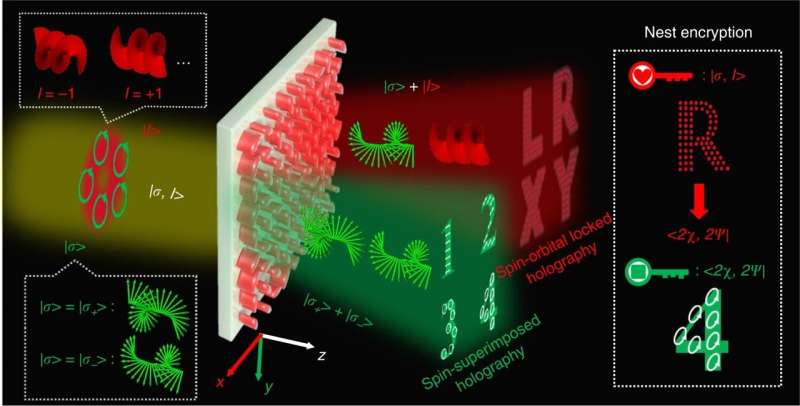
Holography, invented by Gabor, provides an approach for recording and reconstructing the complete information (i.e. intensity and phase) of the light from an object. Since its invention, holographic-related technologies have been widely applied in numerous areas, such as optical display, imaging, data storage, encryption and metrology.
In a new paper published in Light: Science & Applications, a team of scientists led by Professors Yueqiang Hu and Huigao from Hunan University and Zhenwei Xie from Shenzhen University developed a unique method for applying angular momentum (AM) holography for information multiplexing.
Holography based on conventional optical devices such as spatial light modulators (SLM) suffers from the disadvantages of low resolution and small field-of-view, hindering its practical applications. On the other hand, scientists can access the high resolution, ultra-thin thickness, and high-performance counterpart by replacing the conventional components with metasurfaces.
Metasurfaces, composed of two-dimensional subwavelength arrays of nanoscale scatters, allow for manipulating lights with multiple degrees of freedom (DoFs). It provides a new generation of versatile platforms for optical multiplexing holography.
In this context, different physical dimensions of light, such as wavelength, incidence angle, state of polarization (SoP) and time, have been exploited as independent information channels for holographic systems. Having almost exhausted the existing physical dimensions for multiplexing holography, the AM dimension of light has emerged as a new opportunity.
The optical AM, a quantum mechanical description of the photon, has boosted numerous applications in both classical and quantum optical fields, including optical tweezers, the spin-Hall effect, and quantum microscopy. The AM is categorized as orbital angular momentum (OAM) and spin angular momentum (SAM).
Using appropriate spatial frequency sampling of a hologram in momentum space, OAM has been implemented as an independent information carrier for optical holography. OAM-multiplexed holography shows unprecedented capacity for optical information processing due to the unbounded helical mode and intrinsic orthogonality. The linear polarization channels are added to the OAM-dependent holography, further enhancing the information capacity. The SAM has also been explored for multiplexing holography, ranging from spin-dependent to spin-decoupled.
Numerous efforts have been devoted to generating full-polarization vectorial holography. It can offer unlimited multiplexing channels in principle due to the capacity to control the arbitrary polarization vectors on the Poincare sphere (PS), showing great potential for high-capacity optical encryption. Adding the SAM dimension to the existing OAM-multiplexed holography and spatially manipulating the full-polarization vectors simultaneously has not yet been investigated.
The most intuitive design approach is segmenting or interleaving several kinds of meta-atoms, each corresponding to a specific functionality. Such methods will restrict its efficiency and introduce undesirable cross-talks. To overcome these drawbacks, a metasurface consisting of non-interleaved meta-atoms would be an excellent choice. However, the realization of AM holography using either the interleaved or the non-interleaved strategies has remained elusive.
The research team have theoretically and experimentally proven the AM-holography paradigm based on full synergy of the SAM and OAM via a minimalist metasurface. The design methodology of AM-holography depends on independently controlling the two spin eigenstates and arbitrarily overlaying them in each operation channel. This has thereby spatially modulated the resulting waveform at will.
The research team demonstrates an AM meta-hologram that can reconstruct two sets of distinct holographic images to prove the concept. These is the spin-orbital locked (SOL) and spin-superimposed (SS) ones, resulting in the multi-dimensional and multi-channel holography determined by the incident AM. The multi-channel AM meta-holograms have offered additional security locks, allowing us to construct the advanced optical nested encryption platform to revolutionize the existing optical encryption schemes that suffered from limited data capacity or low security.
In the optical nested encryption strategy, the SOL and SS holographic images are employed to encrypt and decrypt the optical information in a specific sequence, making the encoded information invulnerable to certain brute-force attacks.
The nested encryption scheme theoretically owns unbounded information channels from the AM holography, catering to the ever-growing requirement of parallel high-security information transmission. It is worth noting that the design strategy is generalized and can be extended to achieve other waveform shaping functionalities such as spatial structured-light generation and polarization knots.
More information: Hui Yang et al, Angular momentum holography via a minimalist metasurface for optical nested encryption, Light: Science & Applications (2023). DOI: 10.1038/s41377-023-01125-2
Journal information: Light: Science & Applications
Provided by Chinese Academy of Sciences

